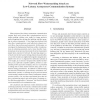16 search results - page 1 / 4 » Preventing Active Timing Attacks in Low-Latency Anonymous Co... |
PET
2010
Springer
13 years 8 months ago
2010
Springer
SP
2007
IEEE
13 years 11 months ago
2007
IEEE
Many proposed low-latency anonymous communication systems have used various flow transformations such as traffic padding, adding cover traffic (or bogus packets), packet droppi...
PET
2010
Springer
13 years 8 months ago
2010
Springer
Abstract. Low-latency anonymous communication networks require padding to resist timing analysis attacks, and dependent link padding has been proven to prevent these attacks with m...
ESORICS
2006
Springer
13 years 8 months ago
2006
Springer
Abstract. Mix networks are a popular mechanism for anonymous Internet communications. By routing IP traffic through an overlay chain of mixes, they aim to hide the relationship bet...
GLOBECOM
2010
IEEE
13 years 2 months ago
2010
IEEE
A mix is a communication proxy that hides the relationship between incoming and outgoing messages. Routing traffic through a path of mixes is a powerful tool for providing privacy....

